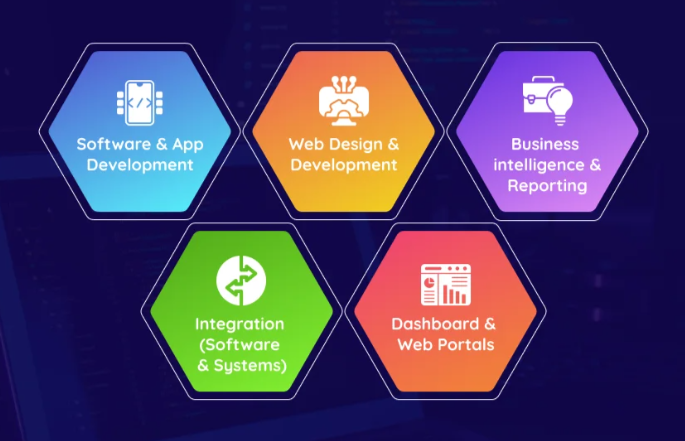For modern supply chains, managing complex logistics is riddled with inefficiency. Yard operations, route planning, inventory management - overseeing these intricate processes manually comes with massive administrative costs.
But what if technology could optimse your workflows, provide real-time visibility, and automate the busywork?
With custom logistics software tailored to your operations, you can revolutionise the way you coordinate logistics and slash costs. Sophisticated algorithms and machine learning streamline everything from staff management to fuel usage.
In this article, we'll explore 5 ways developing customised logistics applications can dramatically simplify supply chain management and reduce overheads for your business. From forecasting demand to digitising paperwork, transformative solutions are within reach.
By partnering with the right software engineering experts, you can implement innovative logistics technology that drives productivity, boosts agility, and cuts costs across your organisation. Let's dive in and uncover how custom apps can transform your supply chain operations.
Automate Yard Management and Load Planning

For warehouses with multiple active shipping and receiving yards, coordinating incoming and outgoing loads is an operational headache. Managing shipments across yards, scheduling dock space, and orchestrating equipment movements requires constant human oversight.
Without optimisation, building trailer loads ends up being a manual, inefficient process. Employees spend countless hours playing Tetris trying to maximise cube space, balance weight distribution, and satisfy order requirements. A single misloaded pallet can throw off the whole delivery timeline.
Custom yard management software helps automate these complex coordination challenges. Sophisticated algorithms analyse your latest shipment volumes, yard capacity, dock and carrier schedules, equipment availability, and more. This allows the system to optimise yard operations and build loads tailored to your constraints.
For example, once you input shipment details, the software can assign each pallet a designated yard location to minimise handling. It can schedule dock doors and staff availability to streamline receiving.
When building outbound loads, the algorithms factor in weight limits, product sizes, stacking requirements, and delivery timelines to create an optimal loading plan. This prevents underutilised cube space or wasteful extra trips.
By pairing real-time data with intelligent optimisation engines, custom yard and load management software takes over the complex fine-tuning required for routing trailers and cargo. The result? Your logistics staff is freed from tedious coordination while cargo turnover increases. Bring efficiency to your shipping yards with custom optimisation.
Optimise Routes and Fleet Fuel Usage

For companies in the warehousing and logistics industry, fuel costs can eat up a significant portion of the budget. With fuel prices fluctuating and environmental concerns mounting, businesses are looking for ways to optimise fuel usage and minimise costs. This is where route optimisation software can make a major impact.
Route optimisation systems allow you to design the most fuel-efficient routes possible, taking into account real-time traffic, weather conditions, road quality, and other factors. The software can generate routings that reduce total mileage traveled, meaning fewer gallons pumped and dollars spent.
Sophisticated solutions factor in specifics on the vehicles in your fleet, including fuel efficiency, capacity, and other attributes. This allows the system to assign the right trucks for each job and fine-tune routing for maximum fuel savings. Some systems even track vehicle performance over time and make adjustments based on actual mpg achieved on different routes.
By reducing mileage and optimising assignments across your fleet, route optimisation technology can yield significant fuel and cost reductions. Some key benefits include:
- Fewer miles driven saves directly on fuel needs
- Shorter routes minimise engine wear-and-tear over the long run
- Optimised load planning reduces inefficiencies like empty backhauls
- Real-time traffic avoidance prevents wasting fuel while idling
- Custom routing per vehicle maximizes mpg performance
In today's world of fast-fluctuating fuel prices, any savings you can achieve goes straight to your bottom line. Route optimisation software pays for itself through fuel savings alone, not to mention reductions in mileage-related maintenance costs.
If fuel efficiency is a priority for your logistics operation, be sure to look at adding route optimisation to your tech stack. The systems provide actionable data to build the most fuel-conscious routings possible, benefiting both your business and the environment.
Improve Labor Efficiency with Task Apps

In the fast-paced warehouse environment, finding ways to maximise labor efficiency is essential for controlling costs and maintaining smooth operations. Task management apps provide an excellent solution for improving workforce productivity.
These apps allow managers to create digital checklists and assign tasks to specific workers based on priorities for the day. Tasks are delivered directly to staff devices in real-time. Workers can quickly view their individual workload and mark tasks as they are completed, with all progress updates syncing to a central dashboard.
For management, having real-time visibility into task status allows them to identify bottlenecks as they occur and shuffle workloads accordingly. For example, if a worker is falling behind schedule, tasks can be reassigned to keep operations running efficiently.
The benefits of task app integration include:
- Real-time task prioritisation and assignment
- Digital checklists replace paper processes
- Workers can update tasks to central system remotely
- Management has up-to-date view of workload status
- Workloads can be adjusted on the fly to maximise efficiency
By connecting and coordinating staff through task apps, warehouses can optimise labor resources. Workers are more productive without wasted time or duplicated efforts. Inventory moves faster through streamlined processes.
As an added benefit, the data gathered through task management apps provides insights into workforce utilisation over time. This allows warehouses to identify opportunities for continual optimisation through scheduling adjustments, training programs, or labor allocation changes.
If you find your warehouse workflow relies heavily on paper checklists and outdated processes, bringing on a real-time task app can kick productivity into high gear. The technology keeps staff connected to priorities, improves visibility for management, and ultimately drives labor efficiency across the board.
Digitise Paperwork and Administrative Tasks

In Australia's warehousing and logistics sector, the amount of paperwork and administrative tasks can be overwhelming. From shipping manifests to inventory logs to compliance forms, the volume of documents that must be managed, updated, and filed is enormous.
By digitising these paper-based processes, warehouses can drive greater efficiency, free up staff time, and minimise errors. Rather than doing manual data entry, digital forms and reporting automate information flows.
For example, scanning barcodes on incoming and outgoing shipments can instantly log manifests and update inventory levels. Digital checklists guide warehouse staff through safety and compliance protocols, with sign-offs stored electronically. Workflows can be configured to automatically route documents to appropriate parties for processing.
The benefits of digitisation include:
- Eliminates manual data entry and filing tasks
- Accelerates report generation and information sharing
- Reduces errors caused by manual processes
- Frees up administrative staff for higher value work
- Enables analysis of digitised data for insights
With automated data capture and paperwork, administrative staff can be reassigned from repetitive manual tasks to more strategic roles. Their time is better utilised on value-added responsibilities like data analysis, customer service, and process improvements.
For Australian warehouse and logistics businesses weighed down by paper trails, digitising administrative workflows delivers manifold efficiency gains. Transactions are accelerated, staff excel in more rewarding roles, and errors are minimised through automation. Most importantly, eliminating slow manual tasks helps warehouses operate at peak productivity.
Forecast Demand to Guide Operational Decisions

For Australian warehousing and logistics companies, being able to accurately forecast demand is critical for optimising operations and costs. With the right technology, businesses can leverage their own supply chain data to generate highly accurate demand projections.
Machine learning algorithms applied to historical order information can detect patterns and correlations. By factoring in variables like seasonality, marketing campaigns, and market conditions, the systems output data-driven demand forecasts.
With these demand projections, warehouses can align inventory planning, storage needs, labour allocation, and transportation requirements.
The benefits of demand forecasting include:
- Inventory kept at optimal levels to meet demand
- Precise labour and storage plans reduce excess capacity
- Transport pre-scheduled based on upcoming requirements
- Contingency plans for demand spike periods
- Overall costs aligned closely to projected volumes
Beyond cost savings, demand forecasting also minimises business risks like inventory shortages, shipping delays, and poor customer service. Operations can be pre-planned around projected demand curves rather than reacting in real-time.
To leverage demand forecasting, warehouses need the right technology stack to ingest supply chain data, run analytical models, and generate easy-to-use projections. Partnering with a solutions provider to implement forecasting tools is recommended.
For Australian warehouse and logistics firms seeking to boost efficiency, machine learning-enabled demand forecasts are a must-have. With data-driven visibility into upcoming demand, critical business decisions can be optimised across the enterprise.
Conclusion

Streamlining and optimising logistics is critical for supply chain success. As we've explored, custom software solutions can drive transformative efficiency gains across yard management, route planning, workforce coordination, and more.
By leveraging the latest algorithms, machine learning, and data analytics, your workflows become smarter, faster, and more cost-effective. Partnering with the right technology experts makes implementing these innovations simple and seamless.
Ready to revolutionise your supply chain? Contact our logistics software specialists today to start a free consultation. We'll assess your operations, identify improvement areas, and recommend custom solutions to reduce costs and power productivity.
With tailored apps supporting your workflows, you can slash logistics overhead, maximise resources, and gain competitive advantage. Now is the time to digitally transform your supply chain. Let's discuss how custom software can propel your logistics operations into the future.

Revolutionise your supply chain operations with custom logistics software.
After reading how tailored applications can optimise workflows, provide visibility, and reduce costs, take the next step by contacting our experts today.
With our free consultation, we'll dive into your specific operations to pinpoint improvements and recommend transformative solutions.
Our data-driven approach has helped leading companies slash overhead costs by double digits through yard automation, route optimisation, forecasting and more.
Don't let inefficiency weigh down your bottom line. Join the future of smart supply chain management.
Seize the competitive edge with tailored logistics software that maximizes resources and boosts agility.
Contact us now to start your revolution. Our team is ready to assess your needs and show how customisation can propel productivity and profits.
The time for digital transformation is now. Let's explore how machine learning and intelligent algorithms can solve your biggest logistics headaches.
Your Software Development Library
Explore our handpicked selection of articles examining contemporary development practises, emerging technologies, and specialised solutions. From practical coding wisdom to advanced architectural insights, our expert resources will help you refine your programming capabilities and transform your development projects.
Building a Humane Economy for Animals & Wildlife: The Role of Software and Technology
Top 15 Desktop Software Development FAQs Answered by C9
Custom Bespoke Software Development for Agriculture & Farming in Australia
Building a Future-Proof Business with Scalable Bespoke Software Development
5 Ways Bespoke Software Can Solve Your Inventory Management Headaches
System and App Integration FAQs Answered by C9 Software
Software Development FAQ answered by C9
The ROI of Custom Software Development: A Guide for Australian Businesses
Beyond the Build: Tips & Tricks to Maximise Efficiency with Custom Software (Australian Businesses)
Scaling with Confidence: Future-Proof Your Business with Scalable Software
AI-Powered Bespoke Software: Building the Future, One App at a Time
Reduce Operational Costs with Custom Logistics Software
5 Ways Custom Software Can Improve Your Retail Business
Avoiding Skill Stagnation with Outsourced Software Partners
The True Hourly Cost of Inhouse vs Outsourced Software Development Team
What are the Benefits and Drawbacks of Inhouse and Outsourcing Software Development Project Management & Administration?
What You Need to Know About Insourced vs Outsourced Software Development Services
Understand the Advantages and Disadvantages of Internal vs. External Software Development for Business Analysis
Modernise Antiquated Business Software Before It's Too Late
Custom Software Development: The Secret Weapon to Boost Your Business's Success
Empower Your Team: Citizen Developers and the Rise of Low-Code/No-Code in Australia